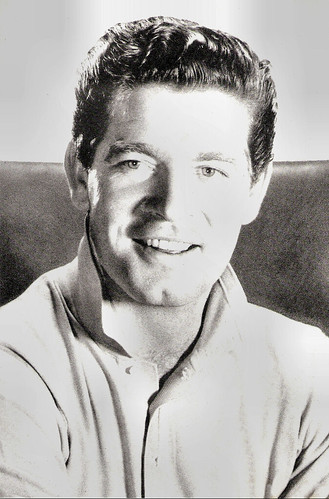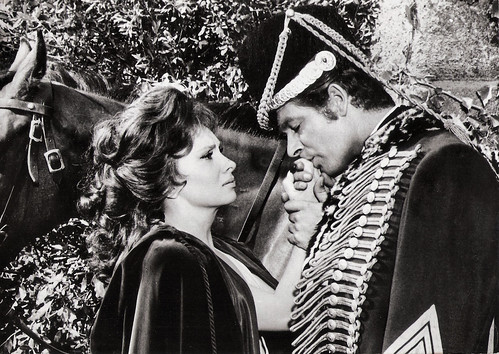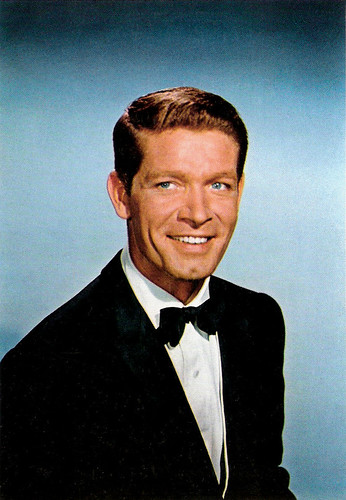
Vintage card. Photo: 20th Century Fox. Stephen Boyd in The Best of Everything (Jean Negulesco, 1959).

Spanish postcard by Archivo Bermejo, no. C-106. Photo: 20th Century Fox. Stephen Boyd in The Best of Everything (Jean Negulesco, 1959).
A racially provocative film
Stephen Boyd was born William Millar in 1931 in Glengormley, Northern Ireland. Boyd was the youngest of nine siblings born to Irish/Canadian parents, truck driver James Alexander Millar and his wife Martha Boyd. Billy attended the local Public Elementary School and Ballyclare High School, but at the age of fourteen Boyd quit school to take up other jobs to help support his family.
He worked in an insurance office and travel agency during the day and rehearsed with a semi-professional acting company at night during the week and weekends. He would eventually manage to be on the list for professional acting companies to call him when they had a role. He eventually joined the Ulster Group Theatre where he learned the behind-the-scenes tasks of the theatre. Boyd became well known in Belfast for his contributions as a gravel-voiced policeman on the Ulster Radio program 'The McCooeys', the story of a Belfast family written by Joseph Tomelty.
Boyd eventually worked his way up to character parts and then starring roles. By nineteen he had toured Canada with summer stock companies. In 1950 he made a coast-to-coast tour of America with the Clare Tree Major Company. In 'A Streetcar Named Desire, he played the lead role of Stanley Kowalski. Boyd would later recall this as “the best performance I ever gave in my life.” By the time he was twenty, Boyd had a wide range of theatre experience, but he longed for the big stage. In 1952 Boyd moved to London as an understudy in an Irish play, 'The Passing Day'. He nearly died during the great flu epidemic in London in 1952. He worked in a cafeteria and busked outside a cinema in Leicester Square to get money as he was literally close to starvation.
Boyd caught his first break as a doorman at the Odeon Theatre. The Leicester Square Cinema across the street recruited him to usher attendees during the British Academy Awards in the early 1950s. During the awards ceremony, he was noticed by actor Sir Michael Redgrave, who used his connections to introduce Boyd to the director of the Windsor Repertory Group. At this point, Boyd’s stage career in the U.K. began to flourish with performances in 'The Deep Blue Sea' and 'Barnett’s Folly'. Boyd’s first role which brought him acclaim was as an Irish spy in the film The Man Who Never Was (Ronald Neame, 1956) with Cliffton Webb, based on the book by Ewen Montagu. Shortly thereafter he signed a ten-year contract with 20th Century Fox studios, who began prepping him for Hollywood. But it would be a while until Boyd actually set foot on a Hollywood back-lot.
Boyd’s next stop was Portugal to make A Hill in Korea (Julian Amyes, 1956), which also featured future stars, Michael Caine and Robert Shaw. In June 1956, Boyd was cast in the nautical, ship-wreck adventure Seven Waves Away/Abandon Ship! (Richard Sale, 1956) starring Tyrone Power. This was filmed in the summer of 1956 in London where the British Navy built a huge 35,000-gallon water tank for the film. In November 1956, Boyd travelled to the British West Indies as part of a large ensemble cast in Darryl Zanuck‘s racially provocative film Island in the Sun (Robert Rossen, 1957), based on the Alec Waugh novel. Boyd portrayed a young English aristocrat who becomes the lover of Joan Collins. Boyd would be loaned out to the J. Arthur Rank production of Seven Thunders/Beast of Marseilles (Hugo Fregonese, 1957), a World War II romance set in Nazi-occupied Marseilles. It was Boyd's most prominent starring film role yet.

Charlton Heston and Stephen Boyd had fun during the filming of Ben-Hur (William Wyler, 1959).

Spanish collectors card in the second Romantica series by Foto-Ficha. Photo: M.G.M.
In the Brigitte Bardot spotlight
After her success in Roger Vadim‘s Et Dieu... créa la femme/And God Created Woman (1956), Brigitte Bardot was given the opportunity to cast her own leading man in her next film, the lusty romance Les bijoutiers du clair de lune/The Night Heaven Fell (Roger Vadim, 1957). She chose Stephen Boyd. Being in the Bardot spotlight added much to Boyd’s film credit, in addition to bringing him notice in Hollywood.
Stephen Boyd finally arrived in Hollywood in January 1958 to take on his first true Hollywood role as the leader of a quartet of renegade outlaws in the Western The Bravados (Henry King, 1958), which starred Gregory Peck and Joan Collins. Even though this was a Hollywood production, the actual filming took place in Morelia, Mexico.
After the filming of The Bravados was completed Boyd auditioned for the coveted role of Messala in Ben-Hur (William Wyler, 1958). Many other actors, including Victor Mature, Kirk Douglas, Leslie Nielsen and Stewart Granger had been considered for the part, but Stephen Boyd’s screen test convinced director William Wyler that he had found the perfect villain for his epic.
Boyd hurried off to join Charlton Heston in Rome in May 1958 to learn the chariot racing aspect of his role. Heston had already been practising behind the chariot for weeks, so Boyd needed to learn the sport quickly. Later, Boyd described the filming experience of Ben-Hur in the Cinecittà Studios in Rome, as the most exciting experience of his life. Years after the film was released, interim Ben-Hur screen-writer and novelist Gore Vidal revealed that Boyd portrayed Messala with an underlying homosexual energy as instructed by Vidal when he greets Ben-Hur Charlton Heston in the opening sequence. In Gore Vidal’s autobiography 'Palimpsest', Vidal describes his discussion first with director William Wyler concerning Messala’s underlying motivation, that being that Messala and Judea Ben-Hur had previously been lovers. This was based on an idea by Vidal to enhance the tension between the two main antagonists.
After Ben-Hur filming was completed, Boyd returned to Hollywood in early 1959 to star with Academy Award winner Susan Hayward in the Canadian-based drama Woman Obsessed (Henry Hathaway, 1959), and appeared in the adaptation of Rona Jaffe‘s novel The Best of Everything (Jean Negulesco, 1959). Ben-Hur was released in December 1959 and made Boyd an international star overnight. His portrayal of the Roman tribune Messala brought in rave reviews. In early 1960 Boyd won the Golden Globe Award for Best Supporting Actor – Motion Picture for his performance in Ben-Hur.

Spanish postcard by Ediciones Raker, Barcelona. no. 324. Photo: 20th Century Fox. Publicity still for The Longest Day (Ken Annakin, Andrew Marton, Bernhard Wicki, 1962).

Spanish postcard by Ediciones Raker, Barcelona, no. 283. Photo: 20th Century Fox. Stephen Boyd in The Longest Day (Ken Annakin, Andrew Marton, Bernhard Wicki, 1962).
Guarded by natives on parole for cannibalism
Stephen Boyd himself chose to do roles in which he felt comfortable. His next choice was The Big Gamble (Richard Fleischer, Elmo Williams, 1961), which featured Darryl F. Zanuck‘s current paramour and French icon Juliette Gréco. The adventure of making this film almost outdid the adventure in the film itself as the crew slept in tents in the jungle that was guarded by natives on parole for cannibalism. Boyd nearly drowned in the Ardèche River during the making of the film.
Boyd was originally chosen to play Mark Antony opposite Elizabeth Taylor in the epic production of Cleopatra (1963) under the direction of Rouben Mamoulian. He began film work in September 1960 but eventually withdrew from the problem-plagued production after Elizabeth Taylor’s severe illness postponed the film for months. Cleopatra was later directed by Joseph L. Mankiewicz, and the role of Mark Antony went to Richard Burton. After several months without active work, Boyd worked on The Inspector (Philip Dunne, 1962), renamed Lisa for the American release. It was based on the novel by Jan de Hartog and co-starred Dolores Hart. The film was made in Amsterdam, London and Wales during the summer of 1961.
Boyd starred with Doris Day in the circus musical Billy Rose’s Jumbo (Charles Walters, 1962). The role earned Boyd a nomination for the Golden Globe Award for Best Actor – Motion Picture Musical or Comedy. In Rome, Boyd acted with Gina Lollobrigida in her long-time pet project Venere imperiale/Imperial Venus (Jean Delannoy, 1962), a romantic epic about the many loves of Pauline Bonaparte, the sister of Napoleon. This film was the first film to be banned by the Motion Picture Association of America for male nudity. Boyd appeared in a humorous bedroom scene, naked, but covered by a sheet. The suggestion of nudity was too much for the censors and the film was never released in the United States. In Spain, he appeared in Samuel Bronston‘s massive production of The Fall of the Roman Empire (1964), directed by Anthony Mann. Boyd’s co-star was Sophia Loren. Although the film did well internationally when it was released in 1964, it was a box office failure in the United States and signalled the end of the Roman epic.
He then filmed the suspenseful The Third Secret (Charles Crichton, 1964) starring Jack Hawkins, Pamela Franklin and Sean Connery’s wife, Diane Cilento. In December 1963, Stephen Boyd became a naturalised U.S. citizen. In 1964, he continued to make films in Europe, travelling to Yugoslavia to star as the villain Jamuga in the epic Genghis Khan (Henry Levin, 1965). Boyd was the top-billed and therefore the top-paid star in the epic, and this apparently caused friction with up-and-coming star Omar Sharif. After completing Genghis Khan, Boyd trekked to Cairo for a brief appearance as the regal King Nimrod at The Tower of Babel in Dino de Laurentiis‘s production of The Bible (John Huston, 1966).
Boyd returned to the United States to start work on the Science Fiction adventure Fantastic Voyage (Richard Fleischer, 1966), co-starring with Raquel Welch. Boyd then joined German star Elke Sommer and music legend Tony Bennett to film the Hollywood drama The Oscar (Russell Rouse, 1966), based on the eponymous Richard Sale novel. The film was a popular success but maligned by film critics. In Iran he filmed his scenes for the United Nations film project Poppies Are Also Flowers (Terence Young, 1966) written by James Bond creator Ian Fleming. Two of Boyd’s projects were ranked among the top twenty-five grossing films of 1966; The Bible at number one and Fantastic Voyage at twenty-two. Next, Boyd starred in a spy thriller Assignment K (Val Guest, 1968) with Swedish model/actress Camilla Sparv. Boyd grew a full beard for his role as the iconic Irish playwright and critic George Bernard Shaw in the Off-Broadway play 'The Bashful Genius' written by Harold Callen. This was Boyd’s first return to the stage since the mid-1950s, and he received excellent reviews.

Austrian press photo by Oafram Filmges. m. b. H., Wien. Photo: Gina Lollobrigida and Stephen Boyd in Venere imperiale/Imperial Venus (Jean Delannoy, 1962).

Italian postcard. Photo: Paramount Film. Stephen Boyd in The Oscar (Henry Levin, 1966).
Rejecting the avances of Raquel Welch
In early 1968, Stephen Boyd was cast as the heavy opposite Sean Connery and Brigitte Bardot in the Western adventure Shalako (Edward Dmytryk, 1968) based on the Louis L’Amour novel. Shalako was filmed in the early part of 1968 in Almería, Spain. After returning to the United States, Boyd took the role of the cruel slave master Nathan MacKay in the Southern 'Slavesploitation' drama Slaves (Herbert J. Biberman, 1969), also starring Ossie Davis and singer Dionne Warwick. The film was loosely based on the famous Harriet Beecher Stowe novel 'Uncle Tom’s Cabin'. Closely following Slaves, Boyd starred in another story about racial tension, this time a World War II made-for-television drama called Carter’s Army/Black Brigade (George McCowan, 1970), featuring a young Richard Pryor.
Boyd began his interest in L. Ron Hubbard‘s Church of Scientology, which would make him one of the first Hollywood stars to be involved in it. Boyd would star and narrate a Scientology recruiting film called Freedom (1970). There is no documentation of his later involvement with Scientology after the early 1970s. During the 1970s the demand for Boyd in Hollywood diminished, so he focused his attention on European films and several television pilots and shows. He made three films in Spain with director José Antonio Nieves Conde: Marta (José Antonio Nieves Conde, 1970) with Marisa Mell, Historia de una traición/The Great Swindle (José Antonio Nieves Conde, 1971), and Casa Manchada (José Antonio Nieves Conde, 1975).
He worked with cult director Romain Gary on the drug thriller Kill! (1971). He also made several Westerns, including Hannie Caulder (Burt Kennedy, 1971) with Raquel Welch, Un hombre llamado Noon/The Man Called Noon (Peter Collinson, 1973) with Richard Crenna and Rosanna Schiaffino, Campa carogna... la taglia cresce/Those Dirty Dogs (Giuseppe Rosati, 1973) with Gianni Garko, and Potato Fritz (Peter Schamoni, 1976) with Hardy Krüger.
His most critically acclaimed role during the 1970s was as a colourful Irish gangster in the UK crime thriller The Squeeze (Michael Apted, 1977) with Stacey Keach and David Hemmings. His last acting stint was a guest star on the popular television show Hawaii Five-O (1977). Boyd died of a massive heart attack on 2 June 1977 at the age of 45 while playing golf with his wife Elizabeth Mills at the Porter Valley Country Club in Northridge, California. Boyd was interred in Oakwood Memorial Park Cemetery in Chatsworth, California.
Boyd was first married in 1958 to Italian-born MCA executive Mariella Di Sarzana during the filming of Ben-Hur. They separated after just three weeks. Boyd lived as a bachelor for most of his life and was wary of marriage after his first experience. His secretary Elizabeth Mills was a permanent resident at his Tarzana home during these years though the two did not marry until 1974. Raquel Welch would claim in 2013 that during the filming of Fantastic Voyage in 1965, she became infatuated with Boyd, who rejected her advances. In her comments she would imply that Boyd was gay, however no evidence of Stephen Boyd being a homosexual exists.

Spanish postcard by CyA, Barcelona, no. 1047. Photo: 20th Century Fox / Radio Films, S.A.E. Stephen Boyd in The Inspector (Philip Dunne, 1962).

Spanish postcard by Ediciones Raker, Barcelona. no. 1047.
Sources: Brigitte Ivory (IMDb), Stephen Boyd Blog, Wikipedia and IMDb.
This post was last updated on 27 July 2023.
No comments:
Post a Comment